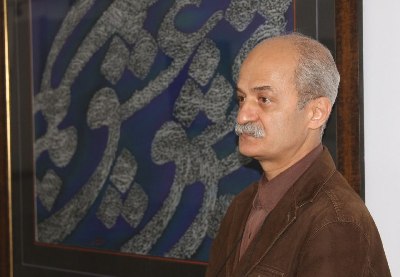Abbas Rahimi
Negarinehkhat (calligraphy painting) style unites Iranian Calligraphy and Miniature
Founder of “Negarinehkhat ” style in Iran: this style tries to establish an emotional and harmonious connection between Iranian calligraphy and miniature simultaneously, and by combining these two significant forms of art, Iranian poetry can be represented in the infinite realm of culture and art.
Abbas Rahimi, born in 1339 in Tehran, is one of the country’s artists and the founder of the Negarinehkhat style in Iran.
His first interest in art dates back to his childhood. His passion and enthusiasm for art, and especially calligraphy, was so great that despite his limitations, he continued to learn and practice this art by watching the works of great calligraphers.

Finally, bypassing various exams, he was accepted in the excellent course of the Iranian Calligraphers Association. But after this success, he was not involved in an artistic activity for eighteen years due to his athletic and heroic life.
Due to his great interest in calligraphy, Rahimi was introduced to master Yadollah Kaboli Khansari, the great master of Iranian Shekasteh Nastaliq. Finally, by the support of his master and by studying and doing research, he created NegarinehKhat (Calligraphy Painting) style and in 2012, he officially unveiled this combined style in the Reza Abbasi Museum with the presence of a renowned master of the Iranian Calligraphers Association.
It is worth mentioning that since 2012, several exhibitions of works of art by Master Abbas Rahimi have been held, including golden night exhibitions in Reza Abbasi Museum, Yazd Art Treasure, Qazvin Mohasses Gallery, Babel Museum, Mashahir Museum, Municipality and Milad Tower East Porch Shalmaneh and Taraneh Baran galleries, Bank Melli Museum, Art Gallery of the Islamic Consultative Assembly, Azerbaijan Online Exhibition. He has also participated in Dubai Art Exhibition (2018) and Qatar Art Festival (2019) – with the participation of artists from 70 countries – and he was one of the six international instructors of the masterclass (advanced class) of the festival.
Master Rahimi is also self-taught in graphic design.
The official logo of Persepolis Sports Club in 1993 and the official logo of the Center for the Dialogue of Religions and Civilizations in 2011 are among his works in the field of graphic design.
He is also one of the famous champions and masters of karate and holds the rank of 8 in Karate from the Federation of the Islamic Republic of Iran.
About Negarinehkhat, Master Rahimi says: I firmly believe that the potential of Iranian calligraphy, by its unlimited and diverse connections, is beyond the ancient and traditional forms and cannot be confined in these forms for hundred years.
With the help of God, the creator of beauties and using natural and eye-catching colours and patterns, I illustrated the meaningful poems of Iranian poets by preserving the novelty and characteristics of Iranian calligraphy and created Negarinehkhat Style. Characteristics of the style are as follows:
- ۱) Preserving novelty of calligraphy and avoiding disarray of letters and words
- ۲) Use of Quranic themes, poems and speeches of the great figures of history, culture and art of Iran, as the main constituent elements of the works of calligraphy
- ۳) Use of calligraphy pen
- ۴) Coordination of themes and images
- ۵) Using colour to create more charming works of art
He emphasizes: Negarinehkhat focuses on preserving the novelty of calligraphy and while inspired by Iranian painting, it seeks to create a visual connection with the aesthetic sense of human beings regardless of nationality, race, age, language and religion. The connection that is established at first glance by the harmony of colours and beauty of the composition (relationship of elements or creating order and unity between them) leads the audience to another realm such as calligraphy and painting.
This style tries to establish an emotional and harmonious connection between Iranian calligraphy and miniature simultaneously, and by combining these two significant forms of art, Iranian poetry can be represented in the infinite realm of culture and art.
